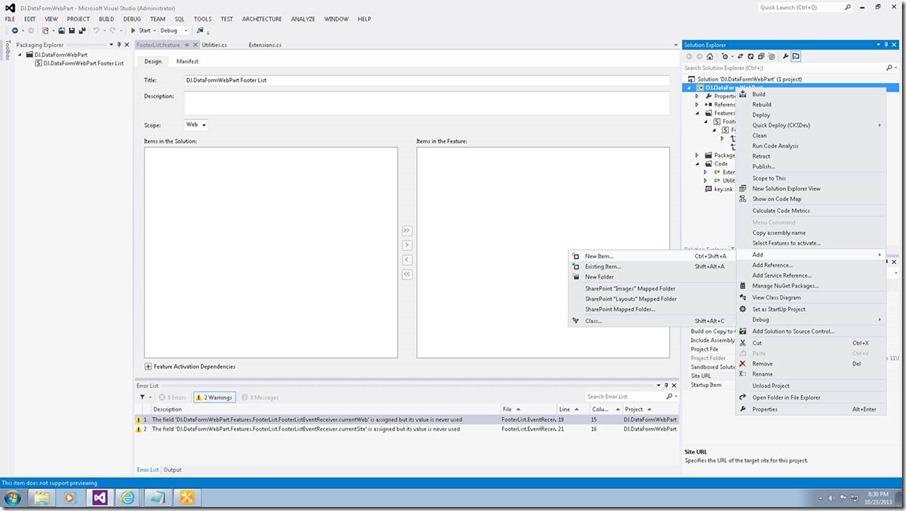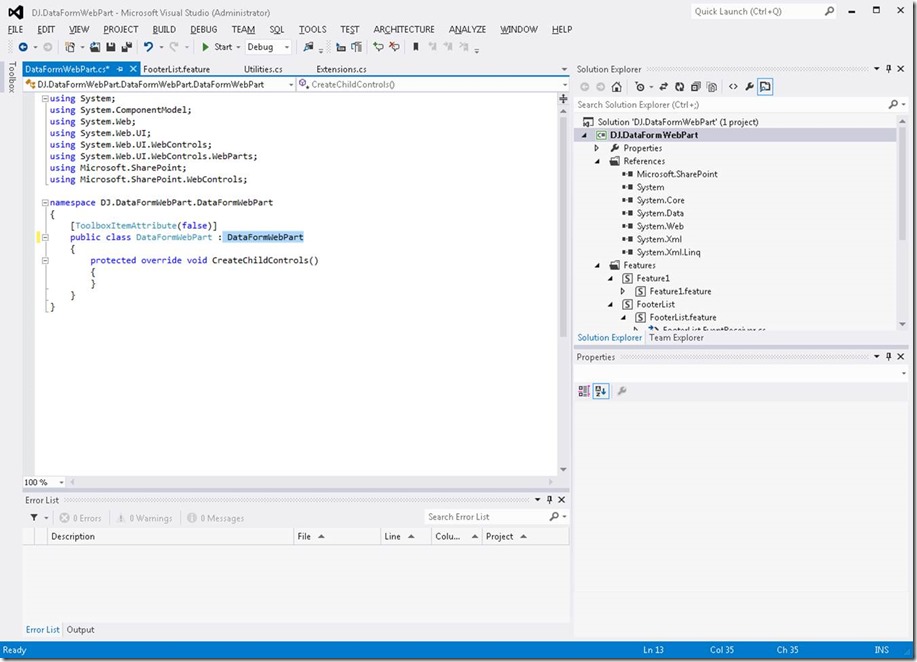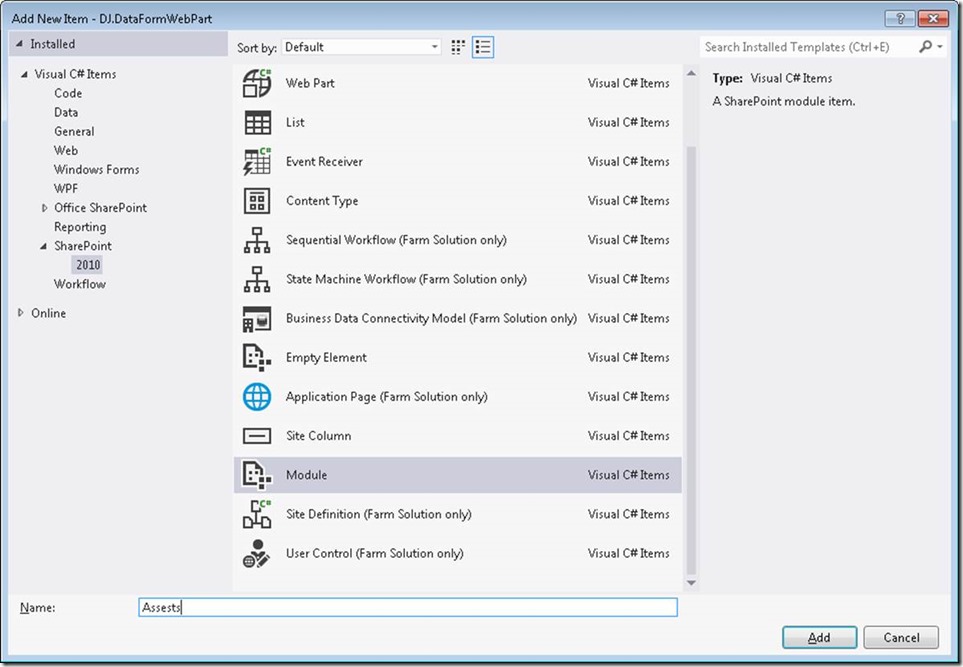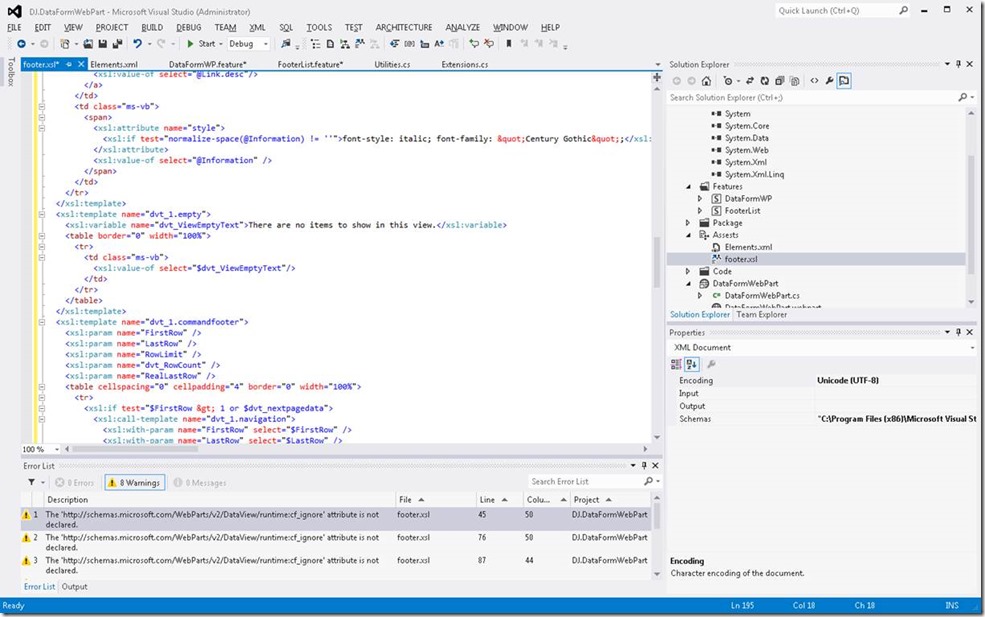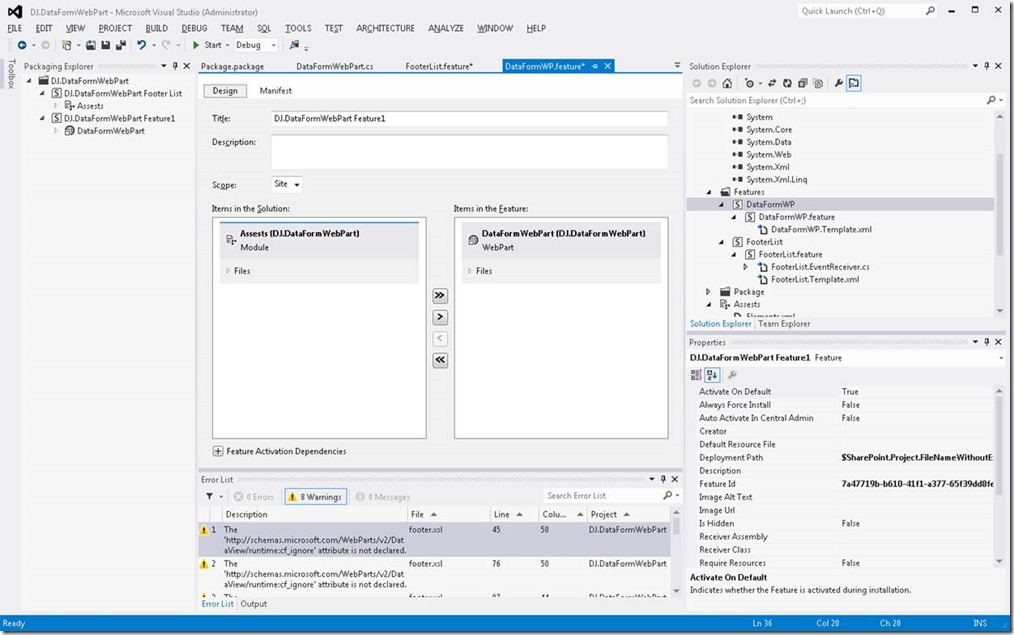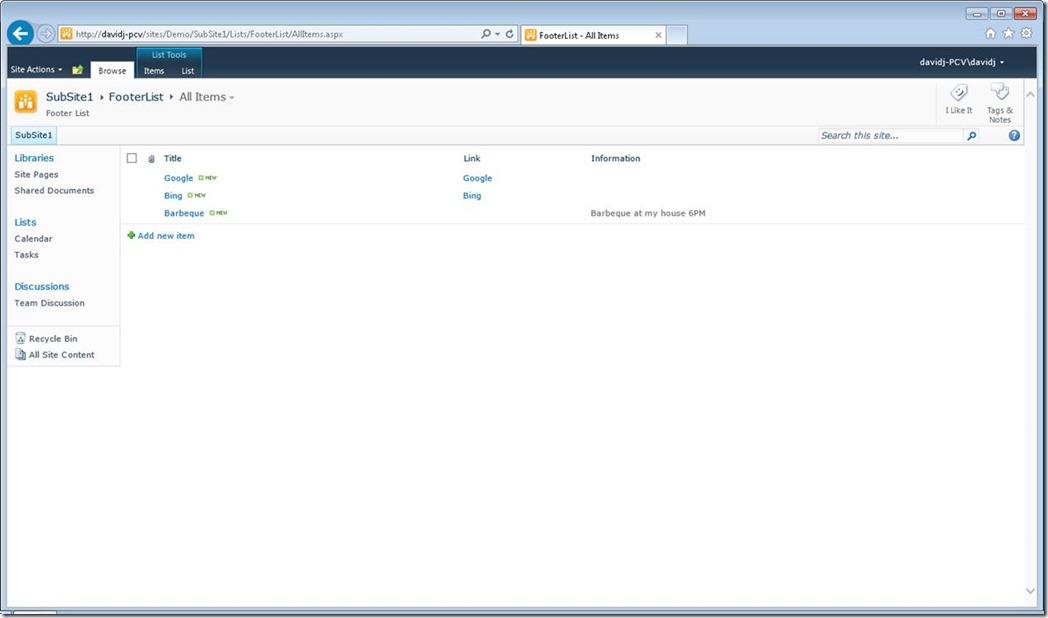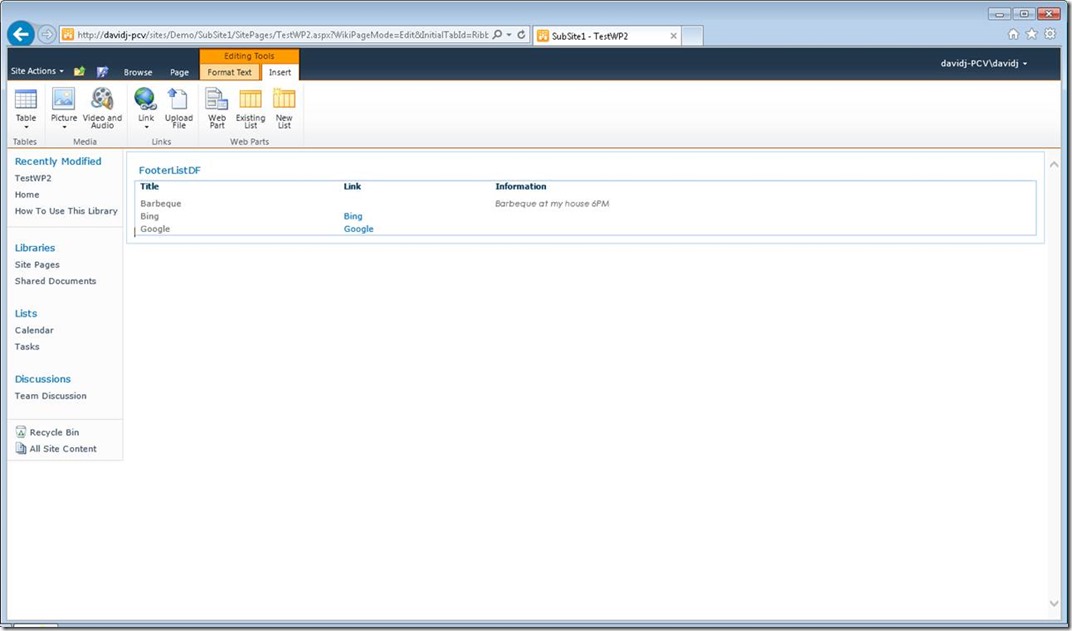Using the Data Form Web Part (SharePoint 2010) Site Agnostically!
Posted
by David Jacobus
on Geeks with Blogs
See other posts from Geeks with Blogs
or by David Jacobus
Published on Thu, 24 Oct 2013 14:31:55 GMT
Indexed on
2013/10/24
21:56 UTC
Read the original article
Hit count: 694
Originally posted on: http://geekswithblogs.net/djacobus/archive/2013/10/24/154465.aspx
As a Developer whom has worked closely with web designers (Power users) in a SharePoint environment, I have come across the issue of making the Data Form Web Part reusable across the site collection! In SharePoint 2007 it was very easy and this blog pointed the way to make it happen: Josh Gaffey's Blog. In SharePoint 2010 something changed! This method failed except for using a Data Form Web Part that pointed to a list in the Site Collection Root! I am making this discussion relative to a developer whom creates a solution (WSP) with all the artifacts embedded and the user shouldn’t have any involvement in the process except to activate features.
The Scenario:
1. A Power User creates a Data Form Web Part using SharePoint Designer 2010! It is a great web part the uses all the power of SharePoint Designer and XSLT (Conditional formatting, etc.).
2. Other Users in the site collection want to use that specific web part in sub sites in the site collection. Pointing to a list with the same name, not at the site collection root!
The Issues:
1. The Data Form Web Part Data Source uses a List ID (GUID) to point to the specific list. Which means a list in a sub site will have a list with a new GUID different than the one which was created with SharePoint Designer! Obviously, the List needs to be the same List (Fields, Content Types, etc.) with different data.
2. How can we make this web part site agnostic, and dependent only on the lists Name?
I had this problem come up over and over and decided to put my solution forward!
The Solution:
1. Use the XSL of the Data Form Web Part Created By the Power User in SharePoint Designer!
2. Extend the OOTB Data Form Web Part to use this XSL and Point to a List by name.
The solution points to a hybrid solution that requires some coding (Developer) and the XSL (Power User) artifacts put together in a Visual Studio SharePoint Solution.
Here are the solution steps in summary:
1. Create an empty SharePoint project in Visual Studio
2. Create a Module and Feature and put the XSL file created by the Power User into it
a. Scope the feature to web
3. Create a Feature Receiver to Create the List. The same list from which the Data Form Web Part was created with by the Power User.
a. Scope the feature to web
4. Create a Web Part extending the Data Form Web
a. Point the Data Form Web Part to point to the List by Name
b. Point the Data Form Web Part XSL link to the XSL added using the Module feature
c. Scope The feature to Site
i. This is because all web parts are in the site collection web part gallery.
So in a Narrative Summary: We are creating a list in code which has the same name and (site Columns) as the list from which the Power User created the Data Form Web Part Using SharePoint Designer. We are creating a Web Part in code which extends the OOTB Data Form Web Part to point to a list by name and use the XSL created by the Power User.
Okay! Here are the steps with images and code! At the end of this post I will provide a link to the code for a solution which works in any site! I want to TOOT the HORN for the power of this solution! It is the mantra a use with all my clients! What is a basic skill a SharePoint Developer: Create an application that uses the data from a SharePoint list and make that data visible to the user in a manner which meets requirements!
Create an Empty SharePoint 2010 Project
Here I am naming my Project DJ.DataFormWebPart
Create a Code Folder
Copy and paste the Extension and Utilities classes (Found in the solution provided at the end of this post) Change the Namespace to match this project
The List to which the Data Form Web Part which was used to make the XSL by the Power User in SharePoint Designer is now going to be created in code! If already in code, then all the better! Here I am going to create a list in the site collection root and add some data to it! For the purpose of this discussion I will actually create this list in code before using SharePoint Designer for simplicity! So here I create the List and deploy it within this solution before I do anything else. I will use a List I created before for demo purposes. Footer List is used within the footer of my master page. Add a new Feature:
Here I name the Feature FooterList and add a Feature Event Receiver:
Here is the code for the Event Receiver: I have a previous blog post about adding lists in code so I will not take time to narrate this code:
using System;
using System.Runtime.InteropServices;
using System.Security.Permissions;
using Microsoft.SharePoint;
using DJ.DataFormWebPart.Code;
namespace DJ.DataFormWebPart.Features.FooterList
{
/// <summary>
/// This class handles events raised during feature activation, deactivation, installation, uninstallation, and upgrade.
/// </summary>
/// <remarks>
/// The GUID attached to this class may be used during packaging and should not be modified.
/// </remarks>
[Guid("a58644fd-9209-41f4-aa16-67a53af7a9bf")]
public class FooterListEventReceiver : SPFeatureReceiver
{
SPWeb currentWeb = null;
SPSite currentSite = null;
const string columnGroup = "DJ";
const string ctName = "FooterContentType";
// Uncomment the method below to handle the event raised after a feature has been activated.
public override void FeatureActivated(SPFeatureReceiverProperties properties)
{
using (SPWeb spWeb = properties.GetWeb() as SPWeb)
{
using (SPSite site = new SPSite(spWeb.Site.ID))
{
using (SPWeb rootWeb = site.OpenWeb(site.RootWeb.ID))
{
//add the fields
addFields(rootWeb);
//add content type
SPContentType testCT = rootWeb.ContentTypes[ctName];
// we will not create the content type if it exists
if (testCT == null)
{
//the content type does not exist add it
addContentType(rootWeb, ctName);
}
if ((spWeb.Lists.TryGetList("FooterList") == null))
{
//create the list if it dosen't to exist
CreateFooterList(spWeb, site);
}
}
}
}
}
#region ContentType
public void addFields(SPWeb spWeb)
{
Utilities.addField(spWeb, "Link", SPFieldType.URL, false, columnGroup);
Utilities.addField(spWeb, "Information", SPFieldType.Text, false, columnGroup);
}
private static void addContentType(SPWeb spWeb, string name)
{
SPContentType myContentType = new SPContentType(spWeb.ContentTypes["Item"], spWeb.ContentTypes, name) { Group = columnGroup };
spWeb.ContentTypes.Add(myContentType);
addContentTypeLinkages(spWeb, myContentType);
myContentType.Update();
}
public static void addContentTypeLinkages(SPWeb spWeb, SPContentType ct)
{
Utilities.addContentTypeLink(spWeb, "Link", ct);
Utilities.addContentTypeLink(spWeb, "Information", ct);
}
private void CreateFooterList(SPWeb web, SPSite site)
{
Guid newListGuid = web.Lists.Add("FooterList", "Footer List",
SPListTemplateType.GenericList);
SPList newList = web.Lists[newListGuid];
newList.ContentTypesEnabled = true;
var footer = site.RootWeb.ContentTypes[ctName];
newList.ContentTypes.Add(footer);
newList.ContentTypes.Delete(newList.ContentTypes["Item"].Id);
newList.Update();
var view = newList.DefaultView;
//add all view fields here
//view.ViewFields.Add("NewsTitle");
view.ViewFields.Add("Link");
view.ViewFields.Add("Information");
view.Update();
}
}
}
Basically created a content type with two site columns Link and Information. I had to change some code as we are working at the SPWeb level and need Content Types at the SPSite level!
I’ll use a new Site Collection for this demo (Best Practice) keep old artifacts from impinging on development:
Next we will add this list to the root of the site collection by deploying this solution, add some data and then use SharePoint Designer to create a Data Form Web Part.
The list has been added, now let’s add some data:
Okay let’s add a Data Form Web Part in SharePoint Designer. Create a new web part page in the site pages library:
I will name it TestWP.aspx and edit it in advanced mode:
Let’s add an empty Data Form Web Part to the web part zone:
Click on the web part to add a data source:
Choose FooterList in the Data Source menu:
Choose appropriate fields and select insert as multiple item view:
Here is what it look like after insertion:
Let’s add some conditional formatting if the information filed is not blank:
Choose Create (right side) apply formatting:
Choose the Information Field and set the condition not null:
Click Set Style:
Here is the result:
Okay! Not flashy but simple enough for this demo. Remember this is the job of the Power user! All we want from this web part is the XLS-Style Sheet out of SharePoint Designer. We are going to use it as the XSL for our web part which we will be creating next.
Let’s add a web part to our project extending the OOTB Data Form Web Part.
Add new item from the Visual Studio add menu:
Choose Web Part:
Change WebPart to DataFormWebPart (Oh well my namespace needs some improvement, but it will sure make it readily identifiable as an extended web part!)
Below is the code for this web part:
using System;
using System.ComponentModel;
using System.Web;
using System.Web.UI;
using System.Web.UI.WebControls;
using System.Web.UI.WebControls.WebParts;
using Microsoft.SharePoint;
using Microsoft.SharePoint.WebControls;
using System.Text;
namespace DJ.DataFormWebPart.DataFormWebPart
{
[ToolboxItemAttribute(false)]
public class DataFormWebPart : Microsoft.SharePoint.WebPartPages.DataFormWebPart
{
protected override void OnInit(EventArgs e)
{
base.OnInit(e);
this.ChromeType = PartChromeType.None;
this.Title = "FooterListDF";
try
{
//SPSite site = SPContext.Current.Site;
SPWeb web = SPContext.Current.Web;
SPList list = web.Lists.TryGetList("FooterList");
if (list != null)
{
string queryList1 = "<Query><Where><IsNotNull><FieldRef Name='Title' /></IsNotNull></Where><OrderBy><FieldRef Name='Title' Ascending='True' /></OrderBy></Query>";
uint maximumRowList1 = 10;
SPDataSource dataSourceList1 = GetDataSource(list.Title, web.Url, list, queryList1, maximumRowList1);
this.DataSources.Add(dataSourceList1);
this.XslLink = web.Url + "/Assests/Footer.xsl";
this.ParameterBindings = BuildDataFormParameters();
this.DataBind();
}
}
catch (Exception ex)
{
this.Controls.Add(new LiteralControl("ERROR: " + ex.Message));
}
}
private SPDataSource GetDataSource(string dataSourceId, string webUrl, SPList list, string query, uint maximumRow)
{
SPDataSource dataSource = new SPDataSource();
dataSource.UseInternalName = true;
dataSource.ID = dataSourceId;
dataSource.DataSourceMode = SPDataSourceMode.List;
dataSource.List = list;
dataSource.SelectCommand = "" + query + "";
Parameter listIdParam = new Parameter("ListID");
listIdParam.DefaultValue = list.ID.ToString(
"B").ToUpper();
Parameter maximumRowsParam = new Parameter("MaximumRows");
maximumRowsParam.DefaultValue = maximumRow.ToString();
QueryStringParameter rootFolderParam = new QueryStringParameter("RootFolder", "RootFolder");
dataSource.SelectParameters.Add(listIdParam);
dataSource.SelectParameters.Add(maximumRowsParam);
dataSource.SelectParameters.Add(rootFolderParam);
dataSource.UpdateParameters.Add(listIdParam);
dataSource.DeleteParameters.Add(listIdParam);
dataSource.InsertParameters.Add(listIdParam);
return dataSource;
}
private string BuildDataFormParameters()
{
StringBuilder parameters = new StringBuilder("<ParameterBindings><ParameterBinding Name=\"dvt_apos\" Location=\"Postback;Connection\"/><ParameterBinding Name=\"UserID\" Location=\"CAMLVariable\" DefaultValue=\"CurrentUserName\"/><ParameterBinding Name=\"Today\" Location=\"CAMLVariable\" DefaultValue=\"CurrentDate\"/>");
parameters.Append("<ParameterBinding Name=\"dvt_firstrow\" Location=\"Postback;Connection\"/>");
parameters.Append("<ParameterBinding Name=\"dvt_nextpagedata\" Location=\"Postback;Connection\"/>");
parameters.Append("<ParameterBinding Name=\"dvt_adhocmode\" Location=\"Postback;Connection\"/>");
parameters.Append("<ParameterBinding Name=\"dvt_adhocfiltermode\" Location=\"Postback;Connection\"/>");
parameters.Append("</ParameterBindings>");
return parameters.ToString();
}
}
}
The OnInit method we use to set the list name and the XSL Link property of the Data Form Web Part. We do not have the link to XSL in our Solution so we will add the XSL now:
Add a Module in the Visual Studio add menu:
Rename Sample.txt in the module to footer.xsl and then copy the XSL from SharePoint Designer
Look at elements.xml to where the footer.xsl is being provisioned to which is Assets/footer.xsl, make sure the Web parts xsl link is pointing to this url:
Okay we are good to go!
Let’s check our features and package:
DataFormWebPart should be scoped to site and have the web part:
The Footer List feature should be scoped to web and have the Assets module (Okay, I see, a spelling issue but it won’t affect this demo)
If everything is correct we should be able to click a couple of sub site feature activations and have our list and web part in a sub site. (In fact this solution can be activated anywhere)
Here is the list created at SubSite1 with new data It.
Next let’s add the web part on a test page and see if it works as expected:
It does! So we now have a repeatable way to use a WSP to move a Data Form Web Part around our sites!
Here is a link to the code: DataFormWebPart Solution
© Geeks with Blogs or respective owner




















